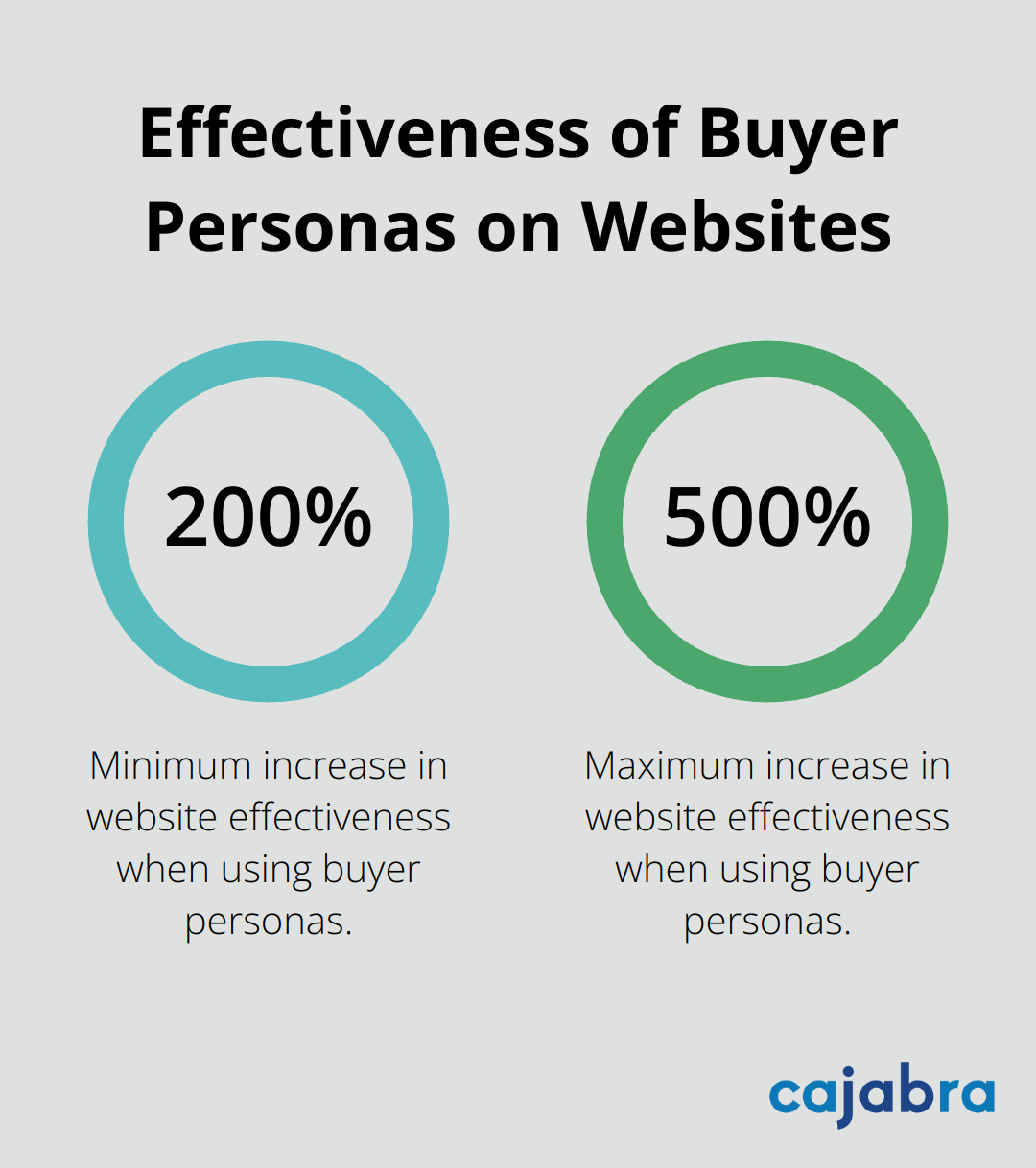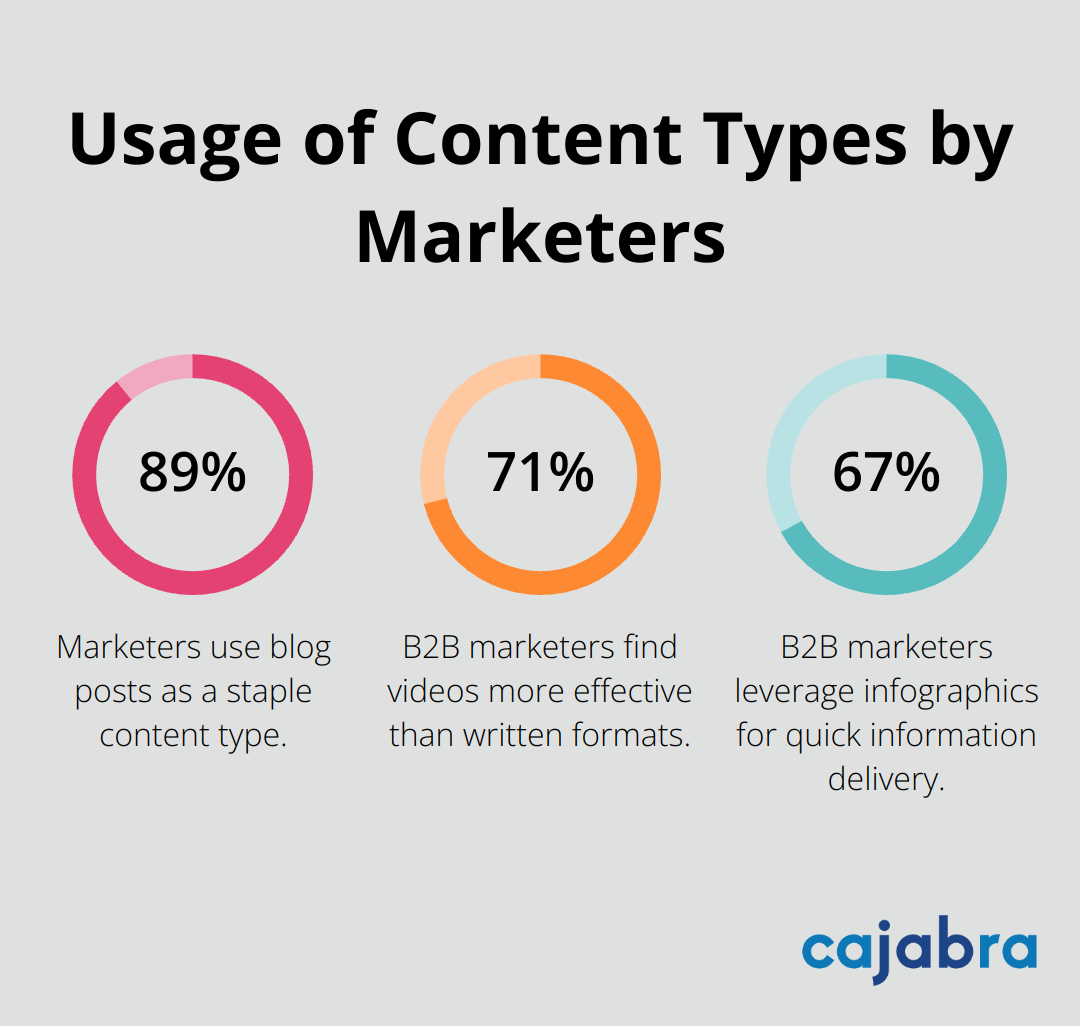
Content is king, but without a solid plan, it's just noise. At Cajabra, LLC, we know that a well-crafted content development plan is the backbone of successful digital marketing.
In this post, we'll show you how to create an effective strategy that aligns with your business goals and resonates with your target audience. Get ready to transform your content game and drive real results.
Creating detailed buyer personas forms the foundation of a successful content development plan. These semi-fictional representations of your ideal customers stem from market research and real data about existing clients. HubSpot's research indicates that using buyer personas can make websites 2-5 times more effective and easier to use for targeted users.

To build these personas, analyze demographics, behavior patterns, motivations, and goals. Use Google Analytics to gather data on your current audience. Conduct surveys or interviews with your best clients to understand their pain points and preferences.
After identifying your audience, define your content goals. Do you want to increase brand awareness, generate leads, or boost sales? Each goal requires a different content approach.
For lead generation, create gated content like whitepapers or webinars. Eighty percent of business decision-makers prefer to get company information from a series of articles versus an advertisement.
Your content should directly support your overarching business objectives. If your company aims to position itself as an industry thought leader, include in-depth analysis pieces and expert interviews in your content plan.
Use the SMART framework to set specific, measurable, achievable, relevant, and time-bound goals for your content. This approach ensures that every piece of content you create has a clear purpose and contributes to your bottom line.
Set up tools like Google Analytics or specialized content analytics platforms to measure the effectiveness of your content. These tools provide valuable insights into how your audience interacts with your content.
Review your metrics regularly and adjust your strategy based on the data. The most successful content plans evolve with changing audience needs and business goals.
As you refine your understanding of your audience and goals, you'll be well-positioned to develop a robust content strategy. Let's explore how to choose the right content types and formats to engage your target audience effectively.
A well-structured content strategy forms the cornerstone of successful marketing. The first step in developing your strategy involves choosing the right mix of content types. Blog posts remain a staple, with 89% of marketers using them (according to the Content Marketing Institute). However, your strategy should extend beyond written content. Incorporate videos, as 71% of B2B marketers find them more effective than written formats. Infographics serve as another powerful tool, with 67% of B2B marketers leveraging them for quick information delivery.

Case studies showcase your successes and build trust through real-world examples. Podcasts are gaining traction too, offering a personal touch that resonates with busy professionals who prefer audio content.
A content calendar serves as your roadmap to consistency. Tools like Asana or Trello help plan your content pipeline. If your blog isn't at least a year old, you should aim to publish 6-8 posts a month around a few important and promising topics.
Plan your content themes around key industry events, seasonal trends, and your product launches. This approach ensures your content remains timely and relevant. Leave room for reactive content that addresses breaking news or emerging trends in your industry.
Clear role assignment and responsibilities prove crucial for smooth execution. Designate a content strategist to oversee the big picture, writers to create compelling copy, and designers to bring visual elements to life. If you're a smaller team, consider outsourcing some tasks to fill expertise gaps.
Establish a clear workflow for content production. Tools like Planable can streamline this workflow, reducing bottlenecks and ensuring everyone aligns on project goals.
Setting the right Key Performance Indicators (KPIs) is essential for tracking success. Focus on metrics that align with your business goals. For lead generation, track landing page visits and form completions. If brand awareness is your aim, monitor social shares and engagement rates.
Use tools like Google Analytics to measure website traffic and user behavior. For social media, platforms like Sprout Social offer in-depth analytics on audience engagement and content performance.
Review these metrics regularly – at least monthly – and use the insights to refine your strategy. A data-driven approach allows you to double down on what works and pivot away from underperforming tactics.
With a robust content strategy in place, you're ready to bring your content plan to life. The next section will explore effective implementation and distribution strategies to maximize the impact of your carefully crafted content.
Start with comprehensive research. Use BuzzSumo to identify trending topics in your industry. Analyze your competitors' content to find gaps you can fill. Engage with your audience through surveys or social media polls to understand their pain points and interests.
For accounting firms, topics related to tax law changes, financial technology, and business advisory services often generate significant interest. Set up Google Alerts for key industry terms to stay on top of breaking news and emerging trends.
When you create content, focus on providing value to your audience. Use the skyscraper technique to improve upon existing content in your niche. For example, if there's a popular article on tax preparation tips, create a more comprehensive guide that includes expert insights and actionable advice.
Incorporate storytelling elements to make your content more engaging. Case studies are particularly effective for B2B audiences. Last year, B2B marketers said case studies/customer stories were the most effective types of content.

SEO is essential for content visibility. Use tools like SEMrush or Ahrefs to conduct keyword research. Try long-tail keywords that have lower competition but high relevance to your target audience. For instance, "small business tax deductions for freelancers" is more specific (and potentially easier to rank for) than "tax deductions."
Structure your content for readability. Use headers, short paragraphs, and bullet points to break up text. Include relevant images, infographics, or videos to enhance engagement.
Distribution is key to content success. Use multiple channels to reach your audience. Share your content on social media platforms where your target audience is most active. For B2B content, LinkedIn is often the most effective platform, with 97% of B2B marketers using LinkedIn for content marketing.
Email marketing remains a powerful tool for content distribution. Segment your email list to send targeted content to specific groups.
Consider repurposing your content for different formats. Turn a blog post into an infographic or a video to cater to different content consumption preferences. This approach can extend the life of your content and reach a wider audience.
Monitor your content performance regularly using analytics tools. Google Analytics provides valuable insights into website traffic and user behavior. Social media platforms offer native analytics to track engagement metrics.
Pay attention to metrics that align with your goals. For lead generation, focus on conversion rates and form submissions. For brand awareness, track social shares and reach.
Use A/B testing to optimize your content strategy. Test different headlines, content formats, or call-to-actions to see what resonates best with your audience. Continuously refine your approach based on these insights to improve your content's effectiveness over time.
A well-crafted content development plan forms the cornerstone of successful digital marketing. It creates a solid foundation through audience understanding, clear objectives, and alignment with business goals. The plan's power manifests in its implementation, boosting effectiveness through research, quality content creation, and optimization for search engines and readers.
Flexibility remains key in content marketing as the digital landscape evolves. We recommend regular review of metrics and strategy adjustments based on audience preferences, industry trends, and technological advancements. Continuous improvement should drive your content efforts, refining your approach through data and feedback collection.
At Cajabra, we specialize in helping accounting firms create and execute effective content strategies. Our services (including the JAB System™) aim to help accountants attract high-value, retainer-based clients. We handle content development and marketing intricacies, allowing you to focus on serving your clients.



